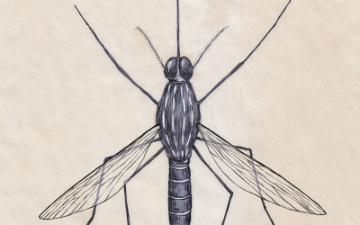| Mosquito | |
|---|---|
 |
|
| A female mosquito Culiseta longiareolata | |
| Scientific classification | |
| Kingdom: | Animalia |
| Phylum: | Arthropoda |
| Class: | Insecta |
| Order: | Diptera |
| Suborder: | Nematocera |
| Infraorder: | Culicomorpha |
| Superfamily: | Culicoidea |
| Family: | Culicidae Meigen, 1830 [1] |
| Subfamilies | |
| Anophelinae Culicinae Toxorhynchitinae |
|
| Diversity | |
| 41 genera | |
Mosquitoes are members of a family of nematocerid flies: the Culicidae (from the Latin culex, genitive culicis meaning “midge” or “gnat”).[3] The word mosquito is from the Spanish and Portuguese for “little fly“.[4] Superficially, mosquitoes resemble crane flies (family Tipulidae) and chironomid flies (family Chironomidae); as a result, casual observers seldom realise that there are important differences between the members of the respective families. In particular, the females of many species of mosquitoes are blood-sucking pests and dangerous vectors of diseases, whereas members of the similar-looking Chironomidae and Tipulidae are not. Even many species of mosquitoes are not bloodsuckers, and many of those that do suck blood do not transmit disease. Also, in the bloodsucking species, only the females suck blood. Furthermore, even among mosquitoes that do carry important diseases, neither all species of mosquito, nor or all strains of a given species transmit the same kinds of diseases, nor do they all transmit the diseases under the same circumstances; their habits differ. For example, some species attack people in houses, and others prefer to attack people walking in forest. Accordingly, in managing public health it is important to know which species, even which strains, of mosquitoes one is dealing with.
Over 3,500 species of mosquitoes have already been described from various parts of the world.[5][6] Some mosquitoes that bite humans routinely act as vectors for a number of infectious diseases affecting millions of people per year.[7][8] Others that do not routinely bite humans, but are the vectors for animal diseases, may become disastrous agents for zoonosis of new diseases when their habitat is disturbed, for instance by sudden deforestation.[9][10]
Several scientists have suggested that complete eradication of mosquitos would not have serious ecological consequences.[11][12] As a generalization this cannot be sustained, however. The roles of various species in different ecologies differ greatly and many are active agents in recycling aquatic detritus or competing with other aquatic pests, for example. In practice control measures focus on mosquito species that are vectors of human or livestock disease, or that are seriously irritant pests. Some, such as members of the genus Toxorhynchites, actually are beneficial predators of other
http://en.wikipedia.org/wiki/Mosquito




